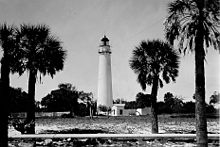Central Florida
Under the previously mentioned "usual" definition, it includes the following 13 counties: Brevard, Citrus, Hernando, Hillsborough, Lake, Orange, Osceola, Pasco, Pinellas, Polk, Seminole, Sumter, and Volusia.
There is a mixture of wetlands, Cypress, Oak, Maple and Pine forests, pastures, prairies and coastline.
Consequently, most of Central Florida cannot accommodate the same tropical plants found in Southern Florida with the exception of coastal areas in the Tampa Bay area, Brevard county, and Indian River county due to maritime influences of the Gulf of Mexico and Atlantic Ocean.
The low temperatures near 50 F. At the end of the Civil War, aside from the cattle, cotton, and coastal lands, much of Central Florida was wetlands.
It took a major drainage project financed by businessman Hamilton Disston in the 1880s to make these wetland areas available for settlement.
The city was an important regional steamship port, owing that status to its location on Lake Tohopekaliga.
Expanding the railroads into Central Florida eliminated the need for Kissimmee's steamship industry.
In the late 1940s, the U.S. military established a missile testing facility on Merritt Island near Cape Canaveral.
When NASA later searched for a long-term base in the 1960s to launch spacecraft, it chose the Merritt Island site next to Cape Canaveral for its access to the testing facility and nearby communities.
Walt Disney wanted a location with abundant available land that was more accessible for the residents of the eastern United States to visit.
Not only was there ample land in Central Florida, but it was inexpensive, and the inland location offered some protection from hurricanes.
[20] Lamme and Oldakowski's survey identifies several demographic, political, and cultural elements that characterize Central Florida and distinguish it from other areas of the state.
[23] Lamme and Oldakowski's survey tracks with Barney Warf and Cynthia Waddell's studies of Florida's political geography during the 2000 Presidential election.
[25] Lamme and Oldakowski's survey also found some cultural indicators that characterize Central Florida.
[citation needed] Exponential growth has fueled Central Florida for the past thirty years.
[28] Selected cities in Central Florida arranged by population: Agriculture has occupied a large portion of Central Florida's economy, with winter strawberries,[30] citrus, timber, vegetables,[31] and aquaculture[32] all making major contributions.
Active military installations in the region include Patrick Space Force Base and Cape Canaveral Space Force Station located on the Atlantic coast; MacDill Air Force Base, Coast Guard Air Station Clearwater and Coast Guard Sector St. Petersburg on the Gulf Coast; and Naval Support Activity Orlando, the Navy Pinecastle Impact (Bombing) Range, and the Avon Park Air Force Range located inland.
These are augmented by major commands that are tenant activities at these installations, such as the headquarters for United States Central Command (USCENTCOM) and the headquarters for United States Special Operations Command (USSOCOM) at MacDill AFB, the Naval Ordnance Test Unit and Coast Guard Station Port Canaveral at Cape Canaveral SFS, and other Active, Reserve, Army National Guard, and Air National Guard activities that are located as either stand-alone facilities or as tenants on the active duty installations.
Additional former facilities that have since been closed and converted to civilian use include Hillsborough Army Air Field, a World War II training range which is now part of a neighborhood, Busch Gardens Tampa Bay, and the University of South Florida; Naval Air Station Sanford, which closed in 1968 and is the present day Orlando-Sanford International Airport; McCoy Air Force Base, which closed in 1975 and is the present day Orlando International Airport; and Orlando Air Force Base, which was transferred to the Navy in 1968 and renamed Naval Training Center Orlando until its BRAC-directed closure in 1999 and conversion to the present day Baldwin Park neighborhood.
Future plans for the port include a rail and natural gas line running directly to Orlando International Airport.
Another major seaport of the region is Port Tampa Bay, which is one of the busiest in the state and is on the verge of a huge expansion which will allow it to compete on an international level.
Limited Access Freeways and Expressways: Major Surface Arterials: * U.S. Highway 41 A regional commuter rail network is being developed in Central Florida.














